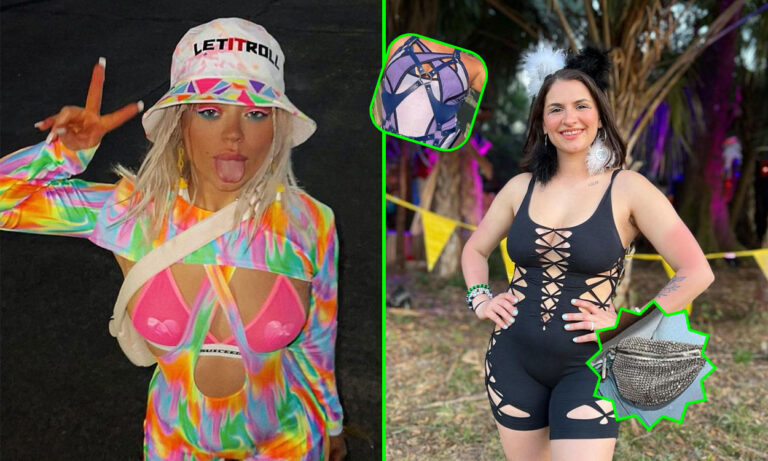The kids are alright: Inside the burgeoning gen Z raving scene and its quest for empowerment
Raving has always been synonymous with youth culture. From polaroids of sweaty teens writhing in abandoned warehouses to half-used glitter packs lying strewn in the corner of the room, reckless adolescence has always defined the rave scene.
Spanning across the rise of acid house music in the 80s, new techno in the 90s and illegal lockdown dance parties in 2020, raving culture has shifted and changed with the marching of time. But are gen Z ravers inherently different from those who took part in the scene 30-odd years ago?
Subcultures and aesthetics come and go online, any chronically scrolling TikTok addict knows that. We’ve seen the likes of clowncore, whimsigothic, and dystopiacore explode in popularity, only to dissipate and lose traction just a few weeks later. So, why would raving culture be any different?
As a gen Zer myself, I believe that the reason why so many young people, generation after generation, get seduced by the raving scene, is because of the fact that it’s one of the most authentic expressions of rebellion. Even as the culture becomes more mainstream and further away from the police’s radar, raving still represents wildness and empowerment—an escape from the establishment’s norms and what’s considered socially acceptable.
Just look at how subversive London’s rave scene is today, with iconic queer-led rave nights like Inferno and GutterRing being staples of counter culture. And these are just the tip of the raving iceberg.
While the choices in fashion, music, and class of drug may have changed over the past few decades, raving culture still represents the same set of beliefs it did all those years ago: freedom, diversity, acceptance, and interpersonal connections.
SCREENSHOT spoke with some high-key gen Z ravers from TikTok to chat about why they think raving culture has resonated with their generation so much, and how the primary pillars of raving still stand. This one’s for you, boomers.
TikToker and Depop aficionado @FestivalStyled, aka Bekah, has been raving for seven years and has accumulated a loyal online following who go to her social media pages for all things raving aesthetic, tips and tricks, and how-to guides.
@festivalstyled The coziest rave set ive ever worn💚 @Intoxicated Clothing #shopsmallbusiness #smallbusiness #smallclothingbrand #clothingunboxing #ravehaul #clothinghaul #outfit #raveoutfit #unboxing #festival #festivaloutfit #funky #funkyfashion #haulvideos #clothinghaulvideos
♬ East Row - Klaudia Gawlas
Not only does Bekah find raving to be incredibly meditative, she’s also found her love of rave music to be intrinsically linked with the fashion that’s associated with it. The creator explained: “It’s empowering for a lot of people to be able to express themselves in many different forms of art.”
But Bekah also emphasises that these kinds of subcultures and aesthetics are in no way a “new thing.” “I’m sure rave clothing has become a bigger industry than it was when raving began, but to say anyone who likes to wear ‘out-there’ rave outfits isn’t there for the music is wrong. Just look at the outfits from the Berlin Love Parade in 1998. I think wacky people wear wacky things and I love looking around and seeing what people have come up with at events,” the TikToker continued.
@festivalstyled Come shopping for RAVE clothes with me in AMSTERDAM 📍🇳🇱🫶🏼 #vlog #rave #comeshoppingwithme #shopping #travelvlog #raveclothes #vintageshops #clothesshop #thrifting #charityshop #amsterdam #charityshopvlog
♬ Illusion of Trust - Gostwork
Another content creator who dedicates her platform to celebrating rave culture is Emma Kapotes, a US-based influencer who documents her love for the electronic music community online. For Kapotes, her favourite thing about raving all comes down to the deeply introspective way it makes her feel.
The creator stated: “I love how present I am and how free I feel at events. Being on the dance floor listening to live music has always made me feel more connected to myself!” Kapotes went on to comment on how she too, finds rave fashion to be incredibly empowering and feels as though it acts as a “creative outlet for [her] to express herself.” She noted: “I feel more like myself fully dressed up in my outfits than I do in my day to day clothes.”
Similarly to how the revival of Y2K brought back the likes of low rise jeans, belly chains and camis, the recent heightened interest in raving culture—or, as it’s known to some, the cyber raver aesthetic—has also helped curate the fits of this generation’s rebels and extroverts. Metallic bodysuits, glitter, and abstract cut-outs has now become synonymous with gen Zers’ disenfranchisement and desire for experience.
How has raving culture changed over the past 20 years?
While there might be some serious disparity between the political and social perspectives of gen Zers versus gen X, or even millennials—there are some valid similarities when it comes to our aversion to the status quo in our youth. And, while social media and technology might’ve changed the way people engage with music, culture and community, the reasoning behind that engagement has always stayed the same.
The internet, for all its wonder and faults, has had a profound role in getting young people into rave culture. As found by Bekah, “we have much more accessibility in regard to different choices of music venues with amazing setups. And we’re also now able to connect with people in other countries to travel there to sample their scenes, something that was never possible before. Most of my raving friends I met online, so I think this community can be used to connect people.”
@ ♬ -
Kapotes reiterated this thought process, stating: “I think the scale and popularity of raving has grown tremendously just given the boom of dance music in the early 2010s, and the live events industry has also grown with the help of social media.” The likes of Instagram and TikTok have helped the commercial rave scene to boom, as well as allowing the underground scene to also solidify itself in the youth zeitgeist.
On the surface, raving culture may seem like a smoke screen for heavy drug use, vandalism and anarchy. But, in reality, it’s been a universal method for people to find solidarity among like-minded communities who champion diversity, inclusion and individualism.
In war-torn Ukraine, the progressive and vibrant dance scene has found a way to continue to thrive. As reported by Vice, Ukrainian DJs and artists gathered together after the Russian invasion and began throwing collective parties for anyone who was seeking respite from the psychological impact of the conflict. Primarily taking place in the nation’s capital Kyiv, the war has actually given the Ukrainian electronic music scene a massive boost, and a number of the events that’re put on donate all proceeds to the army.
Kapotes concluded: “Fashion, production and music may all have evolved, but I still think people have the same intentions for raving that they did 20 years ago. It’s a way to let loose, have fun and feel connected to something bigger than yourself.”
So, there we have it. To rave or not to rave? Gen Zers might be revolutionising some of the ways in which we consume music and immersive dance experiences, but at the heart of it all, we’re all just searching for our own slice of escapism.






